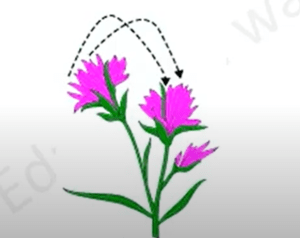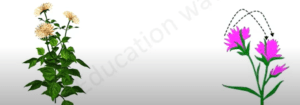Curriculum
- 1 Section
- 5 Lessons
- 10 Weeks
- Biology Sexual Reproduction In Plant Class 125
Biology Sexual Reproduction In Plant Class 12 Part 3
POLLINATION
- The transfer of pollen grains (male gamete) to stigma is known as pollination.
1. Self pollination
2. cross pollination - The transfer of pollen grains are occurred by pollinating agents like wind, water, insects and through birds.
Types of pollination (on the basis of source of pollen)
➤Autogamy– The transfer of pollen grains from the anther to the stigma of the same flower.
seen in those plants which produce chasmogamous and cleistogamous flowers.
Cleistogamous flowers –
In such flowers anthers and stigma lies close to each other. They are closed flowers.
Chasmogamous flowers- Anthers and stigma are exposed. Autogamy
needed for pollination wave y is difficult . pollinating
In such flowers, the anther and stigma lies close to each other. Some plants like viola, oxalis, and commelina produce both types of flowers (chasmogamous) and closed flower (cleistogamous).
Adaptations seen in plant to ensure self pollination.
- Bisexuality – Presence of both the essential whorls in the same flower.
- Homogamy-Maturation of both androecium and gynoecium at the same time i.e there should be synchromy in release of pollen and stigma maturation.
- Cleistogamy– A condition in which flower does not open.
ADVANTAGES OF CLEISTOGAMY
- It ensures seed formation even in the absence of any pollinating agent.
- It is a cheaper for plant as there is no coastly nector or fragnance which plant has to produce for pollination.
DISADVANTAGES OF CLEISTOGAMY
1. The offspring produced have limited genetic diversity.
Geitonogamy
- The transfer of pollen grains from anther to stigma of another flower of the same plant.
- This transfer involves an agents of pollination hence functionally it is known as cross pollination but pollen grain come from the same plant so genetically it is self pollination.

Xenogamy
- The transfer of pollen grains from anther to the stigma of another flower of different plant of the same species.
- This is the only type of pollination which brings genetically different types of pollen grains to stigma.
- So it is fuctionally as well as genetically cross pollination.

Pollinating agents
Agents which carry pollen grains from anthers to stigma of same or different flower.
There are two types:-
BIOTIC AGENTS
-Living organisms which act as agents of pollination.
– insects, birds are examples.
ABIOTIC AGENTS
-non-living organism which act as agents of pollination.
-water and wind are examples.
POLLINATION BY WIND (ANEMOPHILY)
The process of the transfer of pollen from one individual plant to another, whereby the pollen is carried by air currents.
Characteristics of wind pollination
1. stigma is large, branched and feathery
2. Pollen grains are of wind currents.. produced in large amounts and are often smooth and light so t that they can be carried away by the gentlest
3. Pollen grains are light.
4. Non-sticky pollen grains
POLLINATION BY WATER (HYDROPHILY)
A rare form of pollination in which pollen is carried to a flower by water.
It occurs by one of two methods.
1. In Canadian pondweed (Elodea canadensis) the male flowers break off and float downstream until they contact the female flowers.
2. In Zostera, a marine species, the filamentous pollen grains are themselves carried in the water.